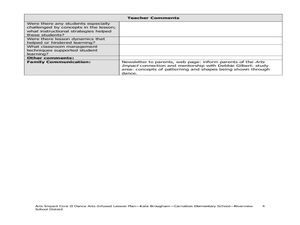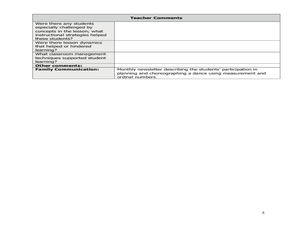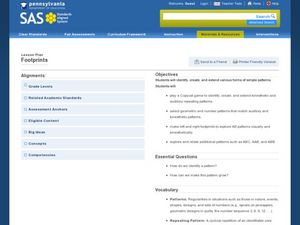Curated OER
Patterns in Dance and Math
Students analyze how repeated body movements and shapes can represent and extend patterns. In this pattern analysis lesson, students discuss patterns in dance, math, and everyday living. Students demonstrate a dance using a sequence of...
Curated OER
Graph Paper Patterns
Young artists divide a piece of graph paper into sections using rectangles, squares, and triangles. They then fill each section with patterns of shape and color. Elementary graders describe how their patterns are organized. Secondary...
Curated OER
Patterns
Students explore simple patterns. In this mathematical thinking geometry lesson plan, students repeat clapping and snapping patterns, and determine what comes next in sound and movement patterns. Students recite "Hey, Diddle,...
Curated OER
Red Circle, Red Circle, What Do You See?
Young learners explore shapes and colors. They listen to Brown Bear, Brown Bear What Do You See? by Bill Martin Jr. and use the same language pattern to create a color and shape book of their own. After that, with the leftover magazine...
Curated OER
Our Pattern Book
Students demonstrate their understanding of patterns and create patterns to share with others. Each student selects a different set of materials to create a pattern. Digital photographs are taken of each student and his or her pattern.
Curated OER
Visual and Number Patterns
Fourth graders develop strategies for identifying geometric and number patterns. In this mathematical patterns lesson, 4th graders use pattern blocks to make repeating patterns with numbers and shapes. Students then explore number...
Curated OER
Terrific Tessellations
Students construct tesselations that fosters their ability to create, transform, and critique their own piece of work. This allows them to become aware of repeated patterns in math, and connect these patterns to artwork.
Curated OER
Shapes and Patterns in Art and Oceans
First graders draw, cut out, and design their own fish shapes by cutting out shapes and putting them together. In this shapes and patterns worksheet, 1st graders also construct a stamp and print patterns with stamps to repeat a...
Curated OER
Beyond the AB Pattern in Dance
Students demonstrate various patterns using dance. In this expressive arts lesson, students are led in a warm-up to demonstrate the AAB pattern, which includes spinning and jumping. Students are broken up into groups and perform several...
Curated OER
Dancing Polygons and Non-Polygons with Patterns
Second graders study movements. In this dance lesson, 2nd graders draw patterns selecting one to represent through movement with their body.
Pennsylvania Department of Education
Playing with Patterns
Students use objects and symbols to create original linear patterns. For this patterns lesson plan, students also translate patterns from one modality to another.
Curated OER
Family Quilts Keep us Warm
Students explore families and culture. In this family and culture lesson, students discuss their families and their similarities and differences. Students read the book The Keeping Quilt by Patricia Polacco and create their own quilt...
Curated OER
All A-buzz About Math
Second graders participate in Math-Eze activities to comprehend word problems. In this word problem instructional activity, 2nd graders recognize why a hexagon is the best shape for a beehive. Students calculate how far bees must travel...
Curated OER
Patterns in Dance
Third graders perform a line dance in the study of math as a pattern. They create and discuss movement solutions derived from movement exploration. They observe that patterns exist in the areas of music and dance and follow the...
Curated OER
Making Patterns
Students utilize skittles and unifix cubes to practice the recognition and creation of a variety of patterns. The created patterns are copied onto sheets and the colors are labeled.
Curated OER
Learning about the World of Color, Object and Shape Patterns
First graders practice identifying and creating patterns by using unifix cubes. In this visual design lesson, 1st graders investigate reoccurring patterns using colors and shapes and extend what is being made with their unifix...
Curated OER
Adire Eleko Cloth Glue Patterns
First graders are introduced to the art form of African Adire Eleko cloth - painted patterned textiles. They use paper, glue and paint to imitate the technique and create similar patterns on paper.
Curated OER
Investigation-How Many Toothpicks?
Seventh graders use toothpicks to investigate a series of designs and identify patterns. Data is organized and analyzed using tables and graphs, and students make generalizations using algebraic expressions.
Curated OER
Be Sharp and Never Flat
An outstanding lesson on music awaits your young composers! They learn about patterns found in music, the different sections of an orchestra, and see the differences between musicians and a composer. Excellent streamed videos and good...
Fraction Bars
Subtraction of Decimals
Here is a fabulous lesson on subtracting decimals with different numbers of decimal places. There are teacher-led activities for learners to engage in, including, modeling decimal subtraction through decimal squares, looking at place...
Curated OER
Patterning Fun
Students practice making patterns with paint and stamps. In this arts and crafts activity, students utilize the floor of their classroom to create a giant pattern on the floor using different colored paints and foam stamps....
Curated OER
Dance and Math
Second graders examine human body movements by measuring the choreography of a dance. In this physical education lesson, 2nd graders participate in a creative dance which is based on specific movements of each limb, which students...
Curated OER
Footprints
Students explore patterns. In this patterns geometry lesson, students identify and extend patterns including body parts, movement, geometric shapes, noises, and footprints. Students create and share an original pattern.
Curated OER
Glad To Meet You
Young scholars explore patterns. For this patterns lesson, students explore patterns in hand-shaking scenarios. Young scholars work in groups to predict and record the number of handshakes that occur in a group.























